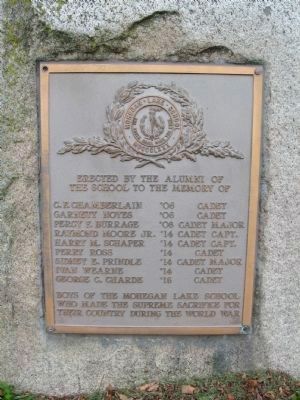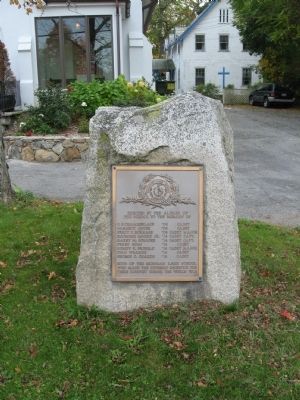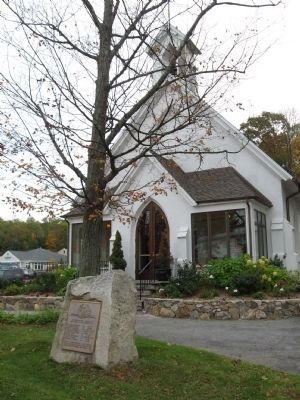Mohegan Lake in Westchester County, New York — The American Northeast (Mid-Atlantic)
Mohegan Lake School World War I Memorial
Inscription.
The School to the Memory Of
Garnett Noyes '06 Cadet
Percy F. Burrage '08 Cadet Major
Raymond Moore Jr. '14 Cadet Capt.
Harry M. Schaper '14 Cadet Capt.
Perry Ross '14 Cadet
Sidney E. Prindle '14 Cadet Major
Ivan Wearne '14 Cadet
George C. Charde '16 Cadet
Who Made the Supreme Sacrifice For
Their Country During the World War
Topics. This historical marker and memorial is listed in this topic list: War, World I.
Location. 41° 19.305′ N, 73° 51.278′ W. Marker is in Mohegan Lake, New York, in Westchester County. Marker is at the intersection of East Main Street (U.S. 6) and Lakeland Street, on the left when traveling west on East Main Street. Located in front of St. Mary's Episcopal Church. Touch for map. Marker is at or near this postal address: 1836 East Main Street, Mohegan Lake NY 10547, United States of America. Touch for directions.
Other nearby markers. At least 8 other markers are within 3 miles of this marker, measured as the crow flies. Oregon Corners (approx. 1.3 miles away); Adams Corners (approx. 2.3 miles away); Old Saint Peter’s Episcopal Church (approx. 2.4 miles away); 160th Anniversary of St. Peter’s (approx. 2.4 miles away); Site of St. Peter’s Church (approx. 2.4 miles away); French Soldiers of the Revolutionary War (approx. 2.4 miles away); Heroes of the American Revolution (approx. 2.4 miles away); Seth Pomeroy & Jeremiah Drake (approx. 2.4 miles away).
Regarding Mohegan Lake School World War I Memorial. St. Mary's Church is the last remnant of the famous Mohegan Lake School, a military academy for boys that turned out some of the leaders of the day. As early as 1880, and until 1934, Mohegan Lake School drew cadets from as far as Europe, the Caribbean and states like Vermont, Georgia and Iowa. Teaching courses from penmanship to Thucididyes, the school produced such thinkers as Robert Moses, the architect of much of modern New York, and several Rockefellers. With an enrollment limited to 42, on eight acres of buildings and parade grounds, the school emphasized "a thorough Christian preparatory education . . . in an atmosphere free from the distracting and pernicious influences of large towns and railroad centers."
Credits. This page was last revised on June 16, 2016. It was originally submitted on October 29, 2010, by Michael Herrick of Southbury, Connecticut. This page has been viewed 1,694 times since then and 105 times this year. Photos: 1, 2, 3. submitted on October 29, 2010, by Michael Herrick of Southbury, Connecticut.


